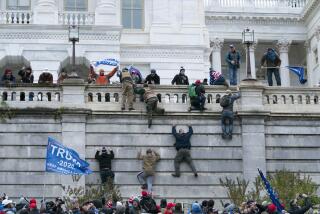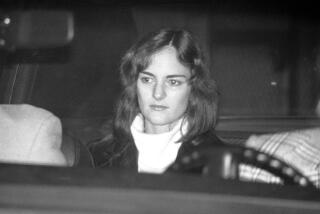Review: â60s and â70s radicals get a fresh look in âDays of Rageâ
Once upon a time, as a college senior in autumn 1970, I organized a committee to block a politician from making a campaign appearance on campus and sought support from a not-unsympathetic faculty member: Students were the target de jour, I explained, the candidate was cynically using the university as a prop. My professor begged to differ: âThis,â meaning America in the â60s, âis all you know, but I can remember when things were different.â What he saw as academic freedom, I thought absurdly naïve.
The conversation returned to me while reading âDays of Rage,â Bryan Burroughâs impressively researched and deeply engrossing history of Americaâs violent revolutionary fringe â the Black Panthers, the Weather Underground, the Symbionese Liberation Army, et al.
Burrough, a staff writer at Vanity Fair and former reporter for the Wall Street Journal, announces at the onset that âwithout a doubt, this book is the single most difficult projection I have ever attempted.â The 21st century has been defined by political terror, but the authorâs challenge, he notes, is to explain why the political adventurism of an earlier era âdidnât seem as insane then as it does now.â Actually it did seem insane then, as did the endless war in Vietnam, understandable only as an expression of American racism and imperial hubris. Moreover, the notion of a Global Village, the prevalence of psychedelic drugs and a heady sense of generational megalomania promoted the feeling that Everything was Now.
âWe actually believed there was going to be a revolution,â one former Weatherman told Burrough. âWe believed Third World countries would rise up and cause crises that would bring down the industrialized West, and we believed it was going to happen tomorrow, or maybe the day after tomorrow, like 1976.â
Things did happen quickly then. Oakland college students Bobby Seale and Huey Newton founded the Black Panthers in late 1966. By mid-1967, when Newark, N.J., and Detroit went up in flames, their organization was a national story; by the time Richard Nixon was elected president in 1968, the Panthers had thousands of members with chapters in almost every major American city, not to mention many California penitentiaries. It was then that war came home. Appointing themselves a Third World vanguard, the Panthers and their offshoots turned urban guerrillas while, as American planes bombed Indochina, self-proclaimed American revolutionaries planted explosive devices.
The FBI reported more than 2,500 domestic bombings during an 18-month period between 1971 and 1972 and this terrorism â far more destructive of property than life â came to seem the new normal.
Burrough recounts an incident where a bomb detonated beneath a seat in a decrepit Bronx movie palace showing William Wylerâs interracial melodrama âThe Liberation of L.B. Jones,â and the blasé audience declined to evacuate. Movies were a heightened reality. The Panthers studied âThe Battle of Algiersâ and âSweet Sweetbackâs Baadassss Song,â and their enforcer Sekou Odinga was compared to the hero of âShaft.â Terry Robbins, a Weatherman who blew himself up making bombs in a Greenwich Village townhouse, was fascinated by âButch Cassidy and the Sundance Kid.â
Increasingly delusional, armed struggle continued through Jimmy Carterâs presidency and beyond. If the sagas of the Panthers, the Weather people and the SLA are familiar, less so are those of Sam Melville, the avant-revolutionary terrorist who began planting bombs across Manhattan during summer 1969, the trigger-happy Black Liberation Army and the Fuerzas Armadas de Liberación Nacional, the Puerto Rican nationalists who Burrough calls âthe most determined bombers in U.S. history.â
Given the cast of characters and wealth of detail, thereâs material here for half a dozen novels. Burrough exhumes the almost totally unknown Bay Area-based New World Liberation Front that, agitating to open free health clinics and reduce utility rates, detonated almost twice as many bombs as the Weather Underground. He also teases out the history of the Family, the post-BLA, post-Weather gang that coalesced in a South Bronx acupuncture clinic and virtually introduces the New England bomber, bank robber and family man Ray Levasseur. Inaugurating his career as a revolutionary in the mid-â70s, Levasseur soldiered on until 1985 and, according to Burrough, inspired the movie âRunning on Empty.â
Was there a method to the madness? While the Panthers, the FALN and the BLA were 20th century desperadoes and the SLA contrived a media spectacle of unsurpassed reckless stupidity, the Weather Underground hearkened back to revolutionary poseurs Dostoyevsky savaged in âThe Possessed.â Burroughâs contempt is thinly veiled.
âIn every conceivable way, the young intellectuals who had come together in 1969 to form Weatherman had utterly failed,â he writes â but thatâs not entirely true. At the least, the group managed to confound and even entrap the FBI. On giving herself up in 1980, their glamorous leader, Bernardine Dohrn (âthe most-wanted underground figure of the eraâ), was able to âwalk away virtually scot-free just weeks after two of her top FBI pursuers had been convicted of crimes against her.â
Having rebelled against their social class and sought to attack what Students for a Democratic Society dubbed âwhite-skin privilege,â Dohrn and her husband, Bill Ayers, wound up tenured professors. Unlike Odinga, who spent 20 years in prison and told Burrough that armed struggle âwas all a mistake,â Ayers has no apologies beyond a lingering sense of inadequacy. âI donât regret setting bombs. I feel we didnât do enough,â he informed a reporter from New York Times in an article that, with an irony too cosmic to be called irony, was published the very day that an act of terror really did change history, on the morning of Sept. 11, 2001.
Hobermanâs most recent book is âFilm After Film: Or, What Became of 21st Century Cinema.â
Days of Rage
Americaâs Radical Underground, the FBI, and the Forgotten Age of Revolutionary Violence
Bryan Burrough
Penguin Press: 585 pp., $29.95
More to Read
Sign up for our Book Club newsletter
Get the latest news, events and more from the Los Angeles Times Book Club, and help us get L.A. reading and talking.
You may occasionally receive promotional content from the Los Angeles Times.







